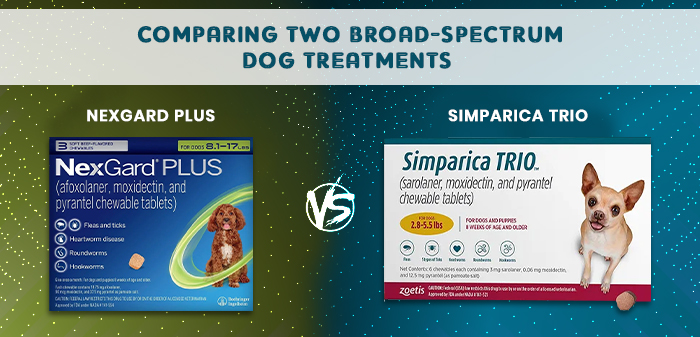Nexgard Plus Vs. Simparica Trio – Comparing Two Broad-Spectrum Dog Treatments
When it comes to ensuring the health and well-being of our canine companions, selecting the right broad-spectrum treatment options is crucial. Nexgard Plus and Simparica Trio are two popular choices among veterinarians and dog owners. Both products are designed to protect against a range of parasites, but they differ in ingredients, effectiveness, and administration. In this in-depth comparison, we will explore these two treatments’ various aspects to help you make an informed decision for your pet’s health.
Composition and Active Ingredients
Nexgard Plus and Simparica Trio offer protection against different types of parasites by combining various active ingredients. Nexgard Plus contains afoxolaner, milbemycin oxime, and pyrantel. Afoxolaner is effective against fleas and ticks, milbemycin oxime targets heartworm and various intestinal worms, while pyrantel also combats intestinal worms.
Simparica Trio, on the other hand, combines sarolaner, moxidectin, and pyrantel. Sarolaner is the active ingredient responsible for killing fleas and ticks, while moxidectin and pyrantel target heartworm and intestinal worms, respectively.
Range of Protection
One of the most critical factors when choosing a broad-spectrum treatment is the range of protection it offers. Nexgard Plus effectively prevents fleas, ticks, heartworm, and a variety of intestinal worms, including hookworms and roundworms.
Simparica Trio offers similar protection against fleas, ticks, heartworm, and intestinal worms like roundworms and hookworms. However, some ticks, such as the American dog tick (Dermacentor variabilis), are specifically mentioned as targets for Simparica Trio, which may be beneficial depending on the prevalent parasite species in your region.
Mode of Action
Both Nexgard Plus and Simparica Trio utilize systemic ororal absorption to deliver their active ingredients throughout the dog’s body, where they work to kill and control parasites. Nexgard Plus’s afoxolaner and Simparica Trio’s sarolaner both target the nervous system of fleas and ticks, causing paralysis and subsequent death of the parasites.
Milbemycin oxime in Nexgard Plus and moxidectin in Simparica Trio prevent heartworm disease by targeting the larval stages of heartworm parasites, while pyrantel in both medications works to eliminate intestinal worms by causing paralysis of the parasites, allowing them to be expelled naturally from the digestive system.
Administration and Dosage
Both Nexgard Plus and Simparica Trio are available as chewable tablets, making them relatively easy for pet owners to administer, even to the more finicky dogs. The frequency of administration for both is monthly, ensuring ongoing protection against parasites.
Dosage recommendations are typically based on the weight of the dog. It is critically important to follow veterinary guidance and the manufacturer’s instructions when administering these treatments to avoid potential overdoses or insufficient protection due to underdosing.
Side Effects and Safety Profile
Any medication may come with potential side effects, and it is important to consider these when choosing a treatment option. Both Nexgard Plus and Simparica Trio are regarded as safe when used as directed by a veterinarian. Nonetheless, potential side effects can include vomiting, diarrhea, lethargy, and lack of appetite. In rarer cases, more severe reactions can occur, so pet owners must monitor their pets following administration and consult a veterinarian if any unusual symptoms arise.
Pet owners should particularly ensure that their dogs are tested negative for any existing heartworm infections prior to starting treatment with either Nexgard Plus or Simparica Trio, as administering these medications to heartworm-positive dogs can lead to severe adverse reactions.
Efficacy and Speed of Action
Nexgard Plus and Simparica Trio are both highly effective in preventing and treating parasitic infections in dogs. Flea and tick elimination typically begins within hours of administration. Nexgard Plus has a favorable speed of action against fleas, generally eliminating existing infestations within 8 hours. Similarly, Simparica Trio works quickly to control fleas and ticks, often within just a few hours.
Cost Considerations
Cost is often a determining factor for pet owners when choosing a treatment option. Prices for Nexgard Plus and Simparica Trio can vary based on the retailer, the dog’s weight, and the purchase quantity. In general, both treatments are similarly priced, although regional differences in availability and discounts from veterinary clinics can impact actual costs. Pet owners should weigh the benefits of comprehensive protection against potentially lower-cost alternatives with narrower spectrums of activity.
Veterinary Recommendations and User Feedback
Both Nexgard Plus and Simparica Trio come with strong veterinary recommendations due to their efficacy and broad range of protection. Veterinarians often choose based on specific parasite pressures in the area or any particular health requirements of the dog.
Feedback from dog owners often highlights the ease of administration and rapid resolution of flea and tick issues. However, some pet owners do report preferences based on how their dog tolerates the specific formulation or any individual adverse reactions.
Environmental Impact and Sustainability
While these products are not typically highlighted for their environmental impact, responsible use within recommended guidelines helps minimize any unintended consequences. Encouraging pet owners to dispose of unused treatments responsibly and to use only when needed ensures that these products do not contribute negatively to the environment.
Final Comparison and Recommendations
Ultimately, the choice between Nexgard Plus and Simparica Trio may depend on personal preferences, specific parasite risks in the region, and the unique needs of the pet. Both products offer extensive broad-spectrum protection for dogs, and consulting with a veterinarian can help tailor the best approach for ensuring the health and safety of your furry friend. It is vital to integrate such treatments as a part of a comprehensive wellness plan that includes regular veterinary check-ups, good nutritional practices, and a safe living environment for optimal pet health.



